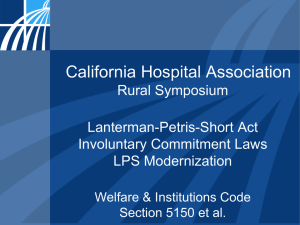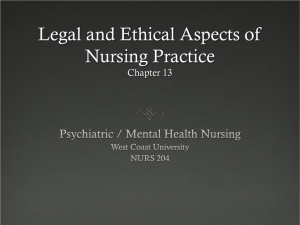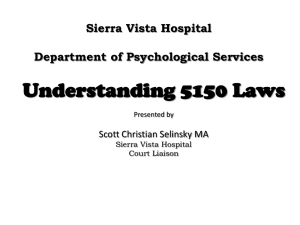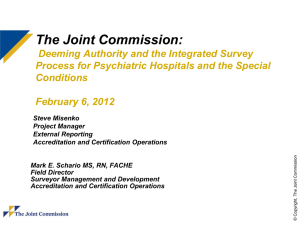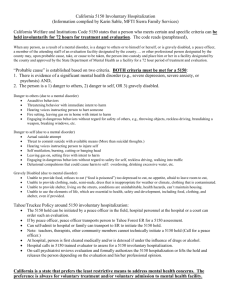LPS Involuntary Commitment Laws Presentation
advertisement
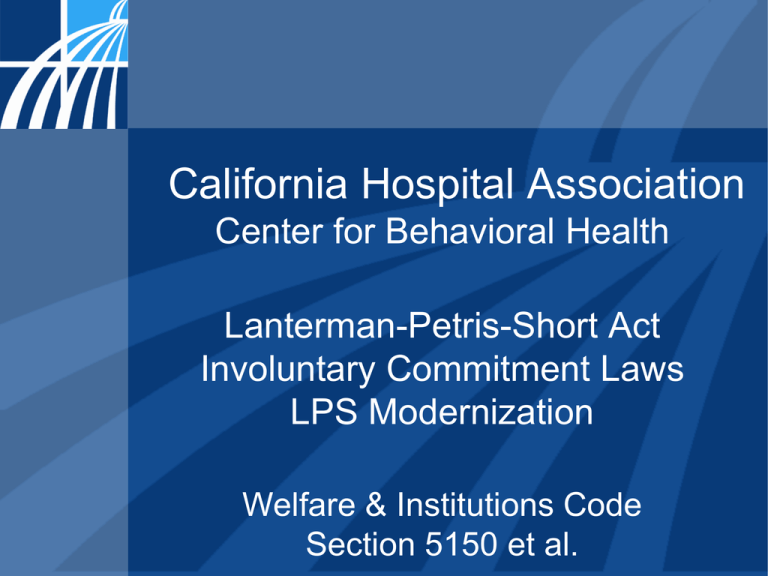
California Hospital Association Center for Behavioral Health Lanterman-Petris-Short Act Involuntary Commitment Laws LPS Modernization Welfare & Institutions Code Section 5150 et al. CHA Modernization Objectives What We Want To Do: Improve timely mental health assessment and treatment for involuntary patients Improve access to the least restrictive level of care Reduce wait times in Emergency Departments (EDs) Reduce non-emergent mental health care visits to EDs Improve the safety level in EDs for all patients and staff Improve the coordination of services between counties, mental health plans, law enforcement, transportation providers, and providers of mental health treatment Standardize who can generate, release, or continue holds Improve uniformity in the law’s application across county lines 2 CHA Modernization Objectives What We Are Not Doing: Changing hold criteria Expanding civil commitments Addressing child/adolescent holds Changing the court process 3 Evolution of CA Mental Health Delivery System LPS Act signed into law 45 years ago in 1967 Within 2 years of implementation, the number of involuntary patients in “state hospital” beds dropped from 18,831 to 12,671 By 1973, there were 7,000 patients remaining in the current 5 “state hospitals” California eventually closed 25,000 “state hospital” institutional beds Currently 5 “state hospitals” with 6,498 beds Only 1,930 are for providing acute psychiatric services Primarily serve individuals who are: Not guilty by reason of insanity Sexually violent predators Admitted by court order 4 Evolution of CA Mental Health Delivery System Community hospitals now provide involuntary care in 130 hospitals with 6,500 beds located in 33 of our 58 counties Federal government promised 1000 community clinics, known as State Clinics Federal government provided funding for 400 clinics Funding for clinics withdrawn; clinics close Feds no longer paid for adult (21-64) IMD Exclusion inpatient psychiatric care in dedicated psychiatric settings with more than 16 beds Radical shift in the delivery system and funding 5 Unanticipated Consequences By 1972: Individuals with a mental illness started showing up in jails and prisons in increasing numbers The number or persons with serious mental illness who are homeless and living on the streets increased dramatically Others remain untreated or inadequately treated, often living with their families 6 Unanticipated Consequences In 1991, the State realigned mental health treatment from the state to the counties’ specialty Medi-Cal Mental Health Plan (MHP) Between 1995 and 2010, California has lost 40 (22%) of its inpatient psychiatric facilities and more than 2700 (almost 30%) of its inpatient beds State funding has not kept pace with mental health needs If you’ve seen one county delivery system, you’ve seen one county delivery system 7 Just the Facts People with SMI die 25 years younger than the general population Victimization: People with SMI are 3 times more likely to be assaulted or raped Approximately 33% of the homeless are people with SMI At least 16% of the prison population have SMI (more than double the percentage of 30 years ago) Suicide is a consequence for 15% of people with SMI 25 attempts for every death by suicide 10% of homicides are committed by someone with SMI Source: Separate and Not Equal: The Case for Updating California’s Mental Health Treatment Law, LPS Task Force II, 2012 8 Hospital Facts 400+ hospitals in California, not including state hospitals and developmental centers 339 Emergency Departments (hospitals are not required to have an ED) with almost 14 million visits per year 70 EDs have closed from 2000 to 2010 About 130 hospitals provide inpatient psychiatric care About 6500 inpatient psychiatric beds to serve nearly 38 million people 25 of California’s 58 counties have no inpatient psychiatric services 9 Hospital Concerns Significant increase in EDs becoming the only treatment provider available 24/7 EDs do not always have the capacity or capability to serve individuals with SMI Federal EMTALA law requires a medical screening for all who present at a hospital. EMTALA has been the law for 25 years and trumps part of the LPS Act. Increasing numbers of individuals are taken to EDs who do not have an emergency physical or psychiatric condition Increasingly, EDs are unable to locate appropriate resources to assist those with mental illness and substance use disorder 10 Original Intent of LPS Act Must be preserved: 1. End inappropriate, indefinite, involuntary commitments 2. Provide prompt evaluation and treatment 3. Guarantee and protect public safety 4. Safeguard individual rights through judicial review 11 Original Intent of LPS Act 5. Protect persons with a mental illness from criminal acts 6. Provide individualized treatment, supervision, and placement for gravely disabled persons 7. Encourage the full use of existing agencies, professional personnel, and public funds 8. Prevent duplication of services and unnecessary expenditures 12 Civil Commitment - Involuntary Who qualifies? Danger to self – suicidal Danger to others – homicidal Gravely disabled due to mental illness – unable to provide for food, clothing, shelter How do patients get to an ED? One-third by law enforcement (squad car) One-third by EMS/transport (ambulance) One-third by family/friend/self 13 CHA Historical Evolution 2006-2009 – increasing number of concerns expressed by non-LPS designated hospital EDs of patients on 5150 detainments being dropped off 2006 – CHA publishes data on available psychiatric inpatient beds by county – 25 counties have none 2009 – CHA sponsors SB 743 to amend H&S 1799.111, relating to mental health, extends ability for non-designated EDs to hold patients from 8 hours to 23 hours 14 CHA Historical Evolution 2010 – CHA conducts ED survey Appropriate use of EDs: on average 42% of patients with mental health needs could have been cared for at a non-emergent level of care Average wait time for admission : From ED to psych bed – 16 hours From an ED to a med/surg bed – 7 hours 2012 – Evaluation of ED utilization by individuals with a psychiatric diagnosis shows a 76% increase between 2006 and 2011. 15 Historical Evolution 2007-Present – downturn in economy Reduction in County resources Law enforcement County Mental Health County Physical Health 2011 – County realignment expanded 2012 – DMH dissolved, duties absorbed by other government entities 16 Historical Evolution 2012 – CHA allocates resources for: Legal review of entire law Data analytics of ED utilization County-by-county analysis of the current application of the law 17 CHA’s Modernization Focus Pre-Admission Focus on adult population only W&I 5150 – detain and transport W&I 5151 – assessment W&I 5152 – treatment Revise statutorily mandated 5150 form State oversight – move from DSS to DHCS in Governor’s budget Clarification – new and existing LPS Act definitions Encourage development of community-based crisis services Clarify “LPS Designation” status – move to deemed status for hospitals 18 CHA’s Modernization Focus Establish uniform statewide standards for who can detain and transport an individual for an assessment under a 5150 hold. Clarify who can conduct a 5151 assessment to validate the 5150 detainment. Clarify who can release an individual from a 5150 detainment. Establish a uniform statewide standard on when the 5152 72-hour involuntary treatment clock starts and stops. Ensure statewide consistent application of the Act to achieve equity and equal protection for all citizens in California. 19 Where to get more information www.calhospital.org includes: Psychiatric bed data LPS Act problem summary Detainment criteria LPS Designations by county 20 Contact information Sheree Kruckenberg, MPA Vice President Behavioral Health (916) 552-7576 skruckenberg@calhospital.org 21
